Jerry Brown and the Regensburg Sacramentary
*A Little Backstory*
Several months back, Graham Hancock invited Jerry Brown, coauthor of The Psychedelic Gospels, to be “Author of the Month” on his website. Brown wrote an article outlining his “holy mushroom” conspiracy theory for the occasion. Graham allowed me to write a critique of Brown’s conspiracy theories and I jumped at the chance. Using critical historical methods, I showed why his conspiracy theory was totally baseless.
Brown responded to my critique. This article is the first of my Replies to that response. I welcome him to respond to this, or any forthcoming articles, I will be writing about his discredited ideas in the coming weeks.
Winston Churchill once reflected on his combat days during the Boer War: “Nothing in life is so exhilarating as to be shot at without result.” While the late Mr. Churchill’s situation was much different from mine—I have never seen war—I can say that my entire professional relationship with Jerry Brown has given me at least a small measure of understanding, vis-à-vis, the feeling to which Mr. Churchill referred.
I would like to first thank Jerry for keeping this conversation going; late last year, after Chris Bennett demonstrated that Jerry bends the truth far too much to be taken seriously, Jerry had indicated that he was done talking about the sacred mushroom conspiracy theory. Bennett had delivered the deathblow to Jerry’s unfounded claims with his article “Fungal Pareidolia”; The Psychedelic Gospels was finished.
I am delighted to see that Jerry has decided to – ahem – resurrect the dialogue.
I’m not going to insult Jerry in this post. While he has made a habit of publicly insulting not only me, but also Brian Muraresku (author of The Immortality Key), I find such public slanders among intellectuals counterproductive and inherently weak; I also feel that focusing on his arguments is time better spent. So let’s turn to them now.
The post Jerry made concerned the Regensburg Sacramentary. Jerry makes a big too-do that it is really called the Sacramentary of Henry II. And he is correct. It is called the Sacramentary of Henry II. But it is also called the Regensburg Sacramentary. Why this is such a big deal to him is confusing unless one factors in that the bulk of Jerry’s arguments are just cheap shots. So with his rather inconsequential swing-and-a-miss out of the way, let’s get into the beef of the discussion.
My main point was that the parasol, as a symbol of domination and victory, seen in ancient Assyrian, Babylonian, and Roman art (below) had also passed into Christian Europe. And that it was this symbol of the parasol as a sign of victory, strength, and domination (not a mushroom) that served as the pedigree for the so-called “mushroom trees” that Jerry erroneously sees in art.
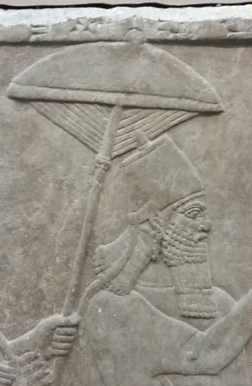
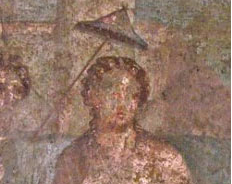
I used the Regensburg Sacramentary to demonstrate that point.
This, it turns out, was an error on my part.
I agree with Jerry. King Henry is not holding a parasol. He is holding a lance. I’m not sure why Jerry used it as an opportunity to insult my Latin abilities (which both he and Carl Ruck have both praised and benefited from in the past), but nonetheless he is wrong to indicate that I translated the writing. Because here’s the thing—I didn’t translate it. In fact, I didn’t even see it. If you look at the image as a whole, the writing is difficult to see, isn’t it (below)?
I didn’t even know it was there.
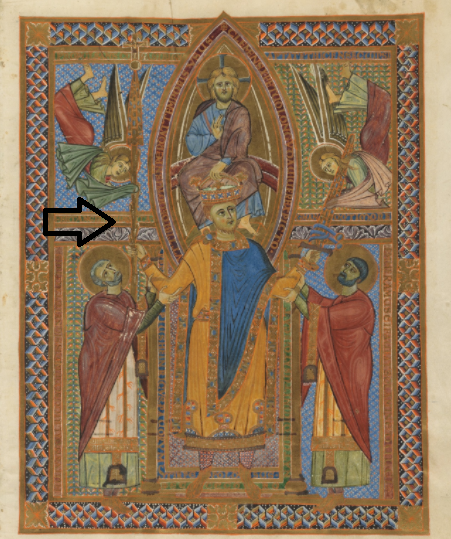
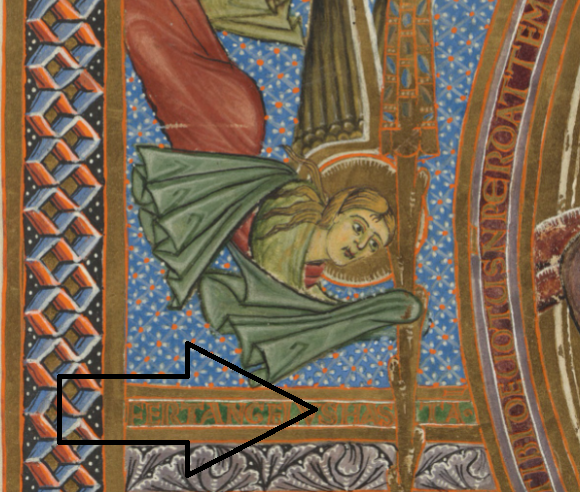
Simply look at any of my published writings; when I translate something I always include the original language in a foot- or endnote. As you can see in my critique of Jerry’s work (from which he pulled this image), no such foot- or endnote exists. It was a good catch made by Jerry. I see that despite his claims of an untimely retirement from this discussion, he is willing to unsheathe his sword!
I welcome the parry.
And since we prefer the scientific approach to history on my side of the debate, I am fine with changing my opinion. The Regensburg Sacramentary shows a lance, not a parasol. And while I don’t believe that that says anything about my Latin abilities, the lifelong student in my heart appreciates the growth.
However, as to my larger point—that Jerry completely ignored—he is still incorrect in his estimations. I had used the Regensburg Sacramentary for no other reason than to show that the parasol as a symbol of domination and victory had made its way into medieval Christian Europe. So, while I agree that Jerry is correct about that particular image, what does he (or anyone else) say about this image from the Harley Manuscript 603 (11th century) that shows an angel holding a parasol as a symbol of authority over a king (below)?
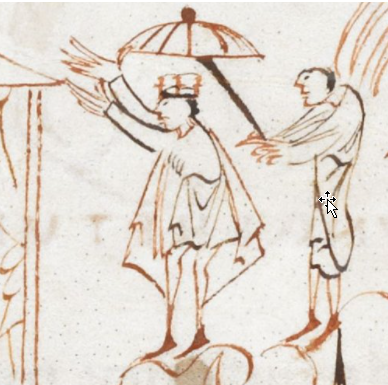
Looks a lot like the Babylonian image above, yes?
Or what about this one, which shows Pope Innocent III (below)?
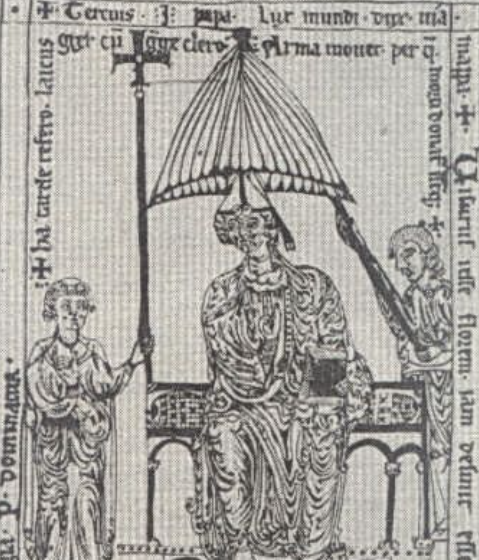
Again, one can’t help notice its similarities to the parasol as an ancient Babylonian symbol of domination.
Will Jerry (or anyone else) claim that this is not a parasol, showing papal power and authority? Note also that both the parasol and a cross are being waved over Innocent’s head – Christ triumphant.
Or this one of the Holy Roman Emperor, Frederick the 1st and Pope Hadrian IV? Again we see both the parasol and crucifix. There is a clear association between the two symbols.
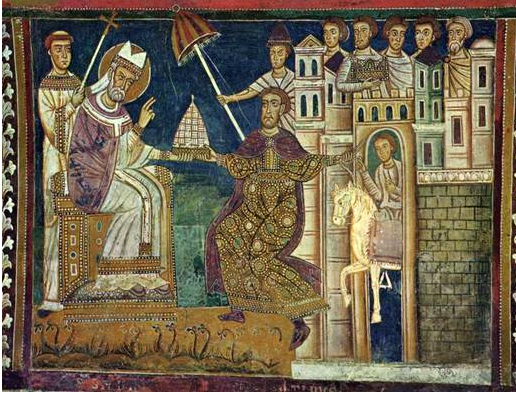
And one more for good measure! This one from Chronik des Konzils zu Konstanz (mid-1400s). Although here, instead of the parasol and cross standing apart, they are brought together at the pinnacle nub of the parasol.

I should point out that Jerry has seen many of these images and chose not to address them in his Reply. Why he chose not to is, I think, quite obvious – to deceive you.
As Jerry well knows, I need only replace the image from the Regensburg Sacramentary with any one of these above images and my main point remains the same: the parasol as a symbol of high status and power was part of medieval European culture; and that high status and power was associated with Christian domination in the form of popes, kings, knights, and emperors. That was the point I was making and, Regensburg Sacramentary or not, I stand by that fact.
Jerry wants to focus on trivial errors instead of arguing the larger picture, because when he argues the larger picture, he loses.
Every time.
Anyway, since Jerry has chosen this as a strategy, I think it germane to our discussion to point out that Jerry (like everyone else) makes small mistakes too. For example, the Gnostic pleroma was not a “path” that “revolved around gaining otherwise hidden spiritual knowledge,” as Jerry imagines in his article, “Sacred Plants the Gnostic Church” (p. 66). (Incidentally, there was no such thing as the “Gnostic Church” in the ancient world—Jerry just made that up.) Anyway, Pleroma means “the Fullness,” and represents “the entire realm of the divine aeons.”(Ehrman, Lost Christianities, p. 123). Interestingly, Jerry cites renowned gnostic scholar Elaine Pagels’ The Gnostic Gospels (p. 144) as his source for this blunder. However, Pagels says nothing of the sort on page 144 or elsewhere. Pagels didn’t say what Jerry needed her to say, so he simply made it up. This seems to be a MAJOR problem with Jerry, as Chris Bennett demonstrated satisfactorily in “Fungal Pareidolia.”
Moreover, in Jerry’s unprovoked attack against my friend and colleague, Brian Muraresku, he claims that “shamanism” is a religion (JPS, 3). Shamanism is most emphatically not a religion. It is a series of techniques, including (but not limited to), fasting, self-flagellation, isolation, and breath work. You wouldn’t call meditation a “religion” would you?
How about yoga? Is that a religion?
Prayer?
Of course not. They are techniques.
Same thing with “shamanism.”
I could multiply Jerry’s trivial blunders over and over again. But I won’t for two reasons: first, as I said earlier, I find it weak as a debate tactic; and second, Chris Bennett has already done a superb job documenting all Jerry’s blunders, half-truths, and bold-faced lies in “Fungal Pareidolia.” I merely address them here in service to my larger argument: namely, everyone makes these kinds of mistakes. How exactly does that one mistake dismiss my larger idea, as evidenced by the slew of medieval parasol imagery above?
It doesn’t.
And finally – my Point!
As you, the reader, can plainly see (regarding the above images), my main point that the parasol as a symbol of dominance and victory made its way into medieval Christian Europe, as evidenced by its association with kings, knights, Holy Roman emperors, crosses, and angels remains both intact and unaddressed by Jerry Brown.
Jerry didn’t bother to contend with all my other evidence for obvious parasols in medieval art, because it shatters his conspiracy theory. I think you, the reader, are smarter than that. I think that you can weigh all the evidence from both sides and form your own conclusions—without all these evasive and duplicitous tactics.
So do you agree or disagree with me, appreciated reader?
Do you think, despite the Regensburg Sacramentary decisively not showing a parasol, that nonetheless the parasol as a symbol of dominance, status, and/or victory did not enter Western Christian Europe?
If not, you are at odds with every single medievalist on the planet.
Additionally, if they are not parasols, well … what are they?
If, on the other paw, you agree they are parasols, then Jerry is not only wrong, but he also attempted to deceive you by not telling you about them and only focusing on one, which I mistook for a parasol. That hardly addresses the point at all.
Highlighting irrelevant errors while ignoring my larger arguments misses the mark completely, and I once again must advise my former friend to come back with a stronger counteroffensive.
I would recommend he start by using the critical historical methods I kindly laid out for him in my evaluation of his erroneous thoughts about the Plaincourault fresco, outlined in my article on Graham Hancock’s website.
Your move, Jerry.

